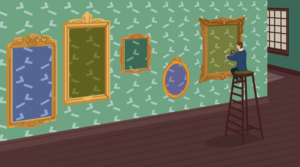How a 5-cent Eye-Patch Created a Million Dollar Story
Key Takeaways
- The Hathaway shirt company, a small business in the 1950s, revolutionized its fortunes by hiring advertising legend David Ogilvy, who created the iconic ‘Man in the Hathaway Shirt’ campaign. The campaign’s success turned Hathaway into the second largest shirtmaker in the U.S.
- The defining feature of the campaign was a 5-cent eye-patch, which Ogilvy picked up on the way to the photo shoot. The eye-patch turned the campaign from a simple product shoot into a story, creating intrigue and prompting the audience to wonder about the man behind the eye-patch.
- The success of the Hathaway campaign underscores the value of embedding detail and narrative into your work, demonstrating that a simple prop can create intrigue, capture the audience’s attention, and significantly boost sales.
Often it’s the small, random details in a story that make it feel authentic. For instance, I love that in the LEGO movie, every character has fingermarks and realistic wear patterns, even though most of it is CGI.
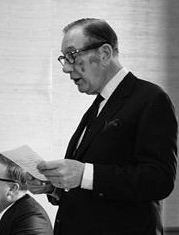
I used this story in a recent webinar and thought I’d re-tell it here. It still makes me smile.
Back in the 1950’s, THIS guy (pictured right) – Ellerton Jette – was CEO of a small men’s shirt company called Hathaway. Hathaway began as a small business in the 1830s and was still a small business in 1950. Jette knew he had to do something big to change the company’s fortunes.
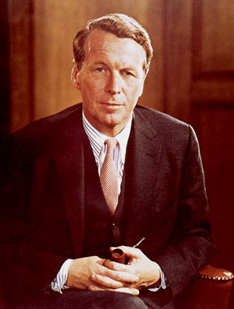
Arguably the single biggest thing a CEO could do in the 1950’s was to get THIS guy (pictured left) on their side. His name was David Ogilvy and he ran a marketing company called Ogilvy & Mather – one of the biggest in the world.
Ogilvy is a legend to people in the advertising industry – sometimes called ‘the father of advertising‘ – but for the rest of us, think of him as the original Don Draper from Mad Men. Here was a guy who was good enough to single-handedly change the fortunes of your company.
Jette’s main problem was Hathaway only had a modest $30k marketing budget to work with – not the kind of budget that Ogilvy & Mather would usually bother with. Ogilvy knew from experience that it’s often the smallest clients that will scrap hardest for every billed minute and copy change.
So, when Jette finally managed to wrangle a meeting with Ogilvy, he was smart enough to immediately kill Ogilvy’s biggest concerns.
He made two promises:
- He’d never change a letter of Ogilvy’s copy
- He’d remain a client for life
The lesson? If you want someone to help YOU, find a way to help THEM first.
Ogilvy surprised him by agreeing to take on the account.
The Man in the Hathaway Shirt
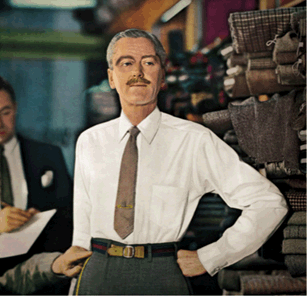
Ogilvy’s campaign idea doesn’t sound all that innovative, even for its time. A worldly, distinguished-looking gentleman model was selected and the photo shoot was booked to take place in a fancy men’s tailor. A touch of James Bond meets Ernest Hemingway. Nothing too remarkable there.
But Ogilvy added one extra detail. On the way to the photo shoot, he stopped at a dime store to purchase a couple of 5-cent costume eye-patches. Fifteen minutes into the photo session he tossed an eye-patch to the model who then wore it for the rest of the shoot.
When the campaign launched, the ‘Hathaway Man’ was given a rich and exotic back-story to go with his rich and exotic shirt materials – all ‘mother-of-pearl buttons’, ‘Indian ivory’ , ‘Scotch voiles fabric’ and ‘Kildun cotton twill’.
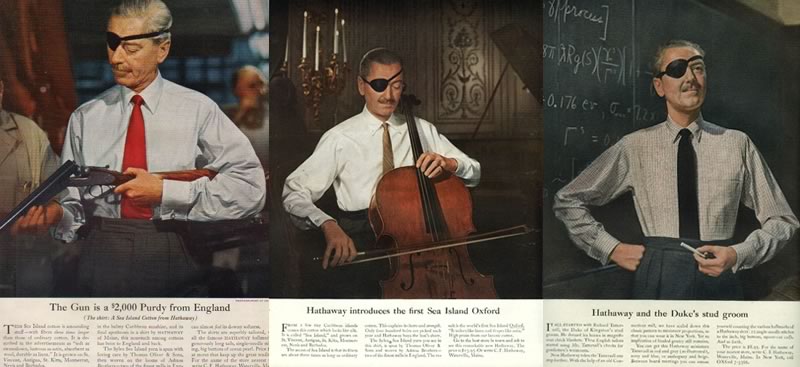
The rest, as they say, is history.
The ‘Man in the Hathaway Shirt‘ became hugely successful for the company and featured in dozens of advertisements till well into the 1980s. Hathaway grew to become the second largest shirtmaker in the U.S.
So, Why Did Ogilvy Add the Eye-patch?
When asked about the Hathaway account, Ogilvy explained that the eye-patch was intended to turn the image from a ‘product photo shoot’ into a story. It seems silly to say, but most of us find it hard to look at this man without wondering:
- Who is he?
- How did he lose that eye?
- Was he in the war?
- Was it a bar fight?
- Is he a spy?
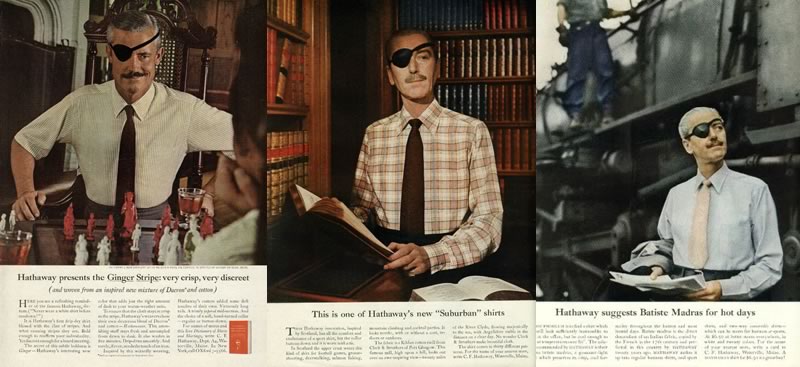
In fact, the first two Hathaway models DID have great real-world back-stories. The original model – Baron George Wrangell – was a genuine Russian aristocrat. The second Hathaway man – Colin Leslie Fox – was originally a London bookmaker who left to lone sail the globe in his 23-foot yacht. Both interesting, sophisticated, ‘can-do’ guys.
Unfortunately, despite the romance, both men owned two functioning eyes. Pity.
But in the end, we make up our own stories. The success of the Hathaway campaign is a killer example of the value of embedding detail and story into your work – and possibly even a little touch of the weird.
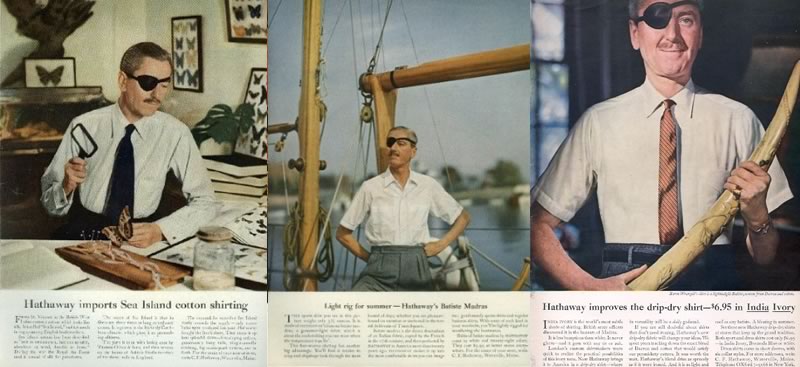
Frequently Asked Questions (FAQs) about the Hathaway Man’s Eye Patch Story
Who was the man behind the Hathaway shirt ad campaign?
The man behind the Hathaway shirt ad campaign was none other than David Ogilvy, a renowned advertising executive. Ogilvy was known for his innovative and out-of-the-box thinking, which he used to create memorable and effective ad campaigns. The Hathaway shirt ad campaign was one of his most successful works, which significantly boosted the sales of Hathaway shirts and made them a household name.
Why was an eye patch used in the Hathaway shirt ad campaign?
The eye patch was used in the Hathaway shirt ad campaign as a unique and attention-grabbing prop. David Ogilvy, the man behind the campaign, believed that the eye patch would make the model stand out and create a sense of intrigue among the audience. His idea worked, and the eye patch became a defining feature of the Hathaway man, making the ad campaign a huge success.
How did the Hathaway shirt ad campaign impact the brand’s sales?
The Hathaway shirt ad campaign had a significant impact on the brand’s sales. The unique and intriguing image of the Hathaway man with an eye patch caught the attention of the audience, leading to a surge in the brand’s popularity and sales. The campaign was so successful that Hathaway shirts became a household name, and the brand saw a substantial increase in its market share.
What was the inspiration behind the Hathaway man’s eye patch?
The inspiration behind the Hathaway man’s eye patch was David Ogilvy’s desire to create a unique and memorable image for the brand. He believed that the eye patch would make the model stand out and create a sense of intrigue among the audience. His idea proved to be successful, as the eye patch became a defining feature of the Hathaway man and played a significant role in the campaign’s success.
How did the Hathaway shirt ad campaign influence the advertising industry?
The Hathaway shirt ad campaign had a profound influence on the advertising industry. It demonstrated the power of a unique and memorable image in capturing the audience’s attention and boosting sales. The campaign’s success inspired many other brands to think outside the box and come up with innovative ideas for their ad campaigns.
Who was the model in the Hathaway shirt ad campaign?
The model in the Hathaway shirt ad campaign was Baron George Wrangell, a Russian aristocrat. His sophisticated and intriguing image, coupled with the eye patch, made him the perfect choice for the Hathaway man.
How long did the Hathaway shirt ad campaign run?
The Hathaway shirt ad campaign ran for over 15 years, from 1951 to 1967. Despite its long run, the campaign never lost its appeal and continued to boost the brand’s sales throughout its duration.
What was the public’s reaction to the Hathaway shirt ad campaign?
The public’s reaction to the Hathaway shirt ad campaign was overwhelmingly positive. The unique and intriguing image of the Hathaway man with an eye patch caught the attention of the audience and made the brand a household name. The campaign was widely praised for its creativity and effectiveness.
How much did the eye patch cost?
The eye patch used in the Hathaway shirt ad campaign cost just 50 cents. Despite its low cost, the eye patch played a crucial role in the campaign’s success and became a defining feature of the Hathaway man.
What lessons can be learned from the Hathaway shirt ad campaign?
The Hathaway shirt ad campaign teaches us the importance of creativity and innovation in advertising. It shows that a unique and memorable image can capture the audience’s attention and significantly boost sales. The campaign also demonstrates the power of a simple prop, like an eye patch, in creating a sense of intrigue and making an ad stand out.
Alex has been doing cruel and unusual things to CSS since 2001. He is the lead front-end design and dev for SitePoint and one-time SitePoint's Design and UX editor with over 150+ newsletter written. Co-author of The Principles of Beautiful Web Design. Now Alex is involved in the planning, development, production, and marketing of a huge range of printed and online products and references. He has designed over 60+ of SitePoint's book covers.

